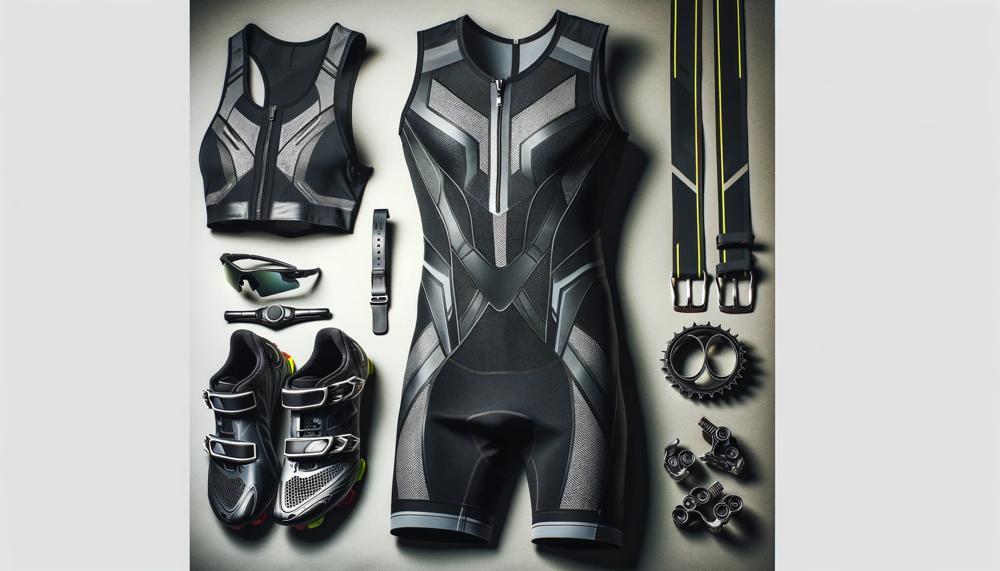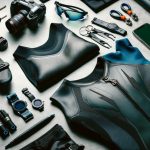Embarking on the triathlon journey is akin to stepping into a world where endurance, speed, and adaptability converge. This multi-disciplinary sport doesn’t just test your limits across swimming, cycling, and running; it also invites an intriguing question: What does one wear to conquer such a varied challenge?
In this comprehensive guide, we’ll dive into the essentials of triathlon attire, ensuring you’re as prepared in your wardrobe as you are in your training.
Whether you’re a seasoned athlete or a first-time participant, understanding the nuances of triathlon clothing is crucial for both comfort and performance. Here’s what you’ll take away from this article:
- The Importance of a Trisuit: Learn why a trisuit is a cornerstone piece of clothing for any triathlete and what makes it so special.
- Transition-Friendly Gear: Tips on selecting attire that’ll save you precious seconds in transition areas.
- Weather-Adaptive Clothing Choices: Guidance on how to choose attire that adapts to weather conditions, ensuring you’re never too hot or too cold.
- Accessories That Make a Difference: From goggles to gel packs, discover the accessories that can give you an edge.
- Sustainability in Sportswear: A nod to environmentally friendly options that don’t compromise on performance.
In striking a balance between casual and professional, this guide aims not only to inform but to inspire.
Join us as we unravel the secrets to selecting the perfect triathlon attire, ensuring that when you next stand at the starting line, you’re not just ready to compete, but also to excel.
Table of Contents
- 1 What To Wear For A Triathlon?
- 2 Preparing for the Swim Leg: Choosing the Right Wetsuit
- 3 Must-Have Accessories for the Swim: Goggles and Swim Cap
- 4 Transitioning to the Bike Leg: The Role of a Tri Suit
- 5 Alternatives to a Tri Suit: Cycling Shorts and Moisture-Wicking Tops
- 6 Running Attire for the Final Leg: Comfort is Key
- 7 Additional Tips for Optimal Performance in a Triathlon
- 8 Conclusion
What To Wear For A Triathlon?
When tackling a triathlon, gearing up with the right attire is not just about comfort; it’s a strategic choice that can greatly influence your performance across swimming, cycling, and running.
Here’s a rundown of the essential items to wear for a triathlon, highlighting how each can boost your race-day performance:
| Item | Description | Performance Benefits |
| Triathlon-specific wetsuit | Made for open water and designed with flexibility and buoyancy in mind. | Improves swim speed by reducing drag and conserving energy through buoyancy. |
| Tri-suit | A versatile, one-piece garment that combines a swimsuit, cycling shorts, and running outfit. | Eliminates the need for changing clothes, with quick-drying fabric to keep you comfortable. |
| Cycling shoes | Shoes that clip onto your bike pedals for a secure fit. | Enhances pedalling efficiency, translating to better speed and reduced fatigue. |
| Running shoes | Lightweight and supportive, designed for impact activities. | Provides cushioning and support, crucial for the final leg to maintain pace and reduce injury risk. |
| Sunglasses | Protective eyewear to shield against UV rays and glare. | Ensures clear vision and reduces eye strain, keeping you focused and comfortable. |
| Cycling helmet | A must-have for safety, designed to protect your head in the cycling segment. | Protects against head injuries and is compulsory for race participation, ensuring you stay in the competition. |
Selecting these essentials not only prepares you physically but also mentally, knowing you’re equipped to tackle each segment with confidence. Remember, triathlon is not just a test of endurance; it’s also a game of smooth transitions and smart gear choices.
Preparing for the Swim Leg: Choosing the Right Wetsuit
When selecting a wetsuit for a triathlon, the factors to mull over are not just about donning a layer of neoprene. It’s a matter of how this aquatic armour melds with the swimmer, cutting through the water with enhanced speed and buoyancy, providing a stroke of advantage that could define the race’s outset. Here’s a dive into the pivotal considerations:
| Factor | Importance | Impact on Performance |
| Material | Yamamoto neoprene is the gold standard for its supreme flexibility and buoyancy. | Reduces drag and conserves energy, allowing for faster swim times. |
| Sleeve Style | Choice between full-sleeved for warmth and buoyancy, or sleeveless for mobility and cooling. | Affects stroke efficiency and thermal comfort, potentially enhancing endurance. |
| Thickness | Variations in suit thickness influence buoyancy and insulation. | Thicker suits boost floatation but may restrict movement; a balance is crucial. |
| Fit and Range of Motion | A precise fit ensures no water ingress, while flexibility allows unimpeded motion. | Ensures efficient swimming with minimal resistance and no chafing or discomfort. |
| Hydrodynamic Coating | Special coatings reduce water friction. | Improves speed by allowing smoother transitions through water. |
| Regulations Compliance | Adherence to IRONMAN and USAT guidelines for wetsuit use based on water temperature. | Ensures eligibility and avoids disqualification. |
| Price vs. Performance | High-end wetsuits offer the best features but at a price; mid-range options can still provide competitive benefits. | Investment in a quality suit pays off in improved performance, though budget-friendly options are also viable. |
Material isn’t merely about the fabric but the engine of your aquatic locomotion. Opting for a wetsuit crafted from Yamamoto neoprene isn’t just a choice; it’s an alliance with buoyancy and flexibility that lessens drag and conserves your energy for the battles ahead.
Sleeve Style plays a dual role in your aquatic escapades. Full-sleeved guardians of warmth and floatation versus sleeveless heralds of mobility and cooling. The choice isn’t black and white but deeply personal, tailored to your swimming style and the climate of your conquests.
Thickness and Buoyancy are intertwined, a thicker suit’s embrace brings greater floatation, a boon in the water yet a potential shackle to your range of motion. Striking a harmony between buoyancy and flexibility is akin to choosing the right blade for battle.
Fit and Range of Motion are paramount; a wetsuit should feel like a second skin, a seamless extension of your body that wards off water while allowing your limbs the freedom to perform their aquatic ballet.
The Hydrodynamic Coating is the unsung hero, a layer of magic that lets you glide through the water with lesser friction, a subtle yet potent force multiplier for your speed.
Regulations Compliance ensures that your chosen armour falls within the sacred texts of IRONMAN and USAT, a nod to the guardians of the sport, ensuring your battle is not only brave but also just.
Lastly, the Price vs. Performance debate is ever-present. While the allure of top-tier suits is undeniable, the wise warrior knows that the right suit is one that balances the scales of cost and capability.
Must-Have Accessories for the Swim: Goggles and Swim Cap
Choosing the ideal goggles and swim cap for a triathlon transcends mere preference; it’s about securing gear that meshes well with your ambition to excel. Here’s a distilled insight into what to keep an eye out for:
Goggles and Swim Cap: Essential Features for Triathlon
| Feature | Goggles | Swim Cap |
| Fit | Ensure a snug, yet comfortable fit that avoids pressure marks or slippage. Adjustable straps and nose pieces enhance fit. | Seek caps that sit tight without causing headaches, ensuring no drag. Test different sizes for the best head shape compatibility. |
| Comfort | Opt for soft silicone seals and ample adjustability for a bespoke, irritation-free experience. | Silicone or neoprene caps trump latex for a gentler, snug embrace on your scalp. |
| Durability | Shatter-proof lenses and robust straps are a must to weather the rigours of open water and UV exposure. | Prefer silicone or neoprene for their resilience against the harshness of saltwater, chlorine, and the sun. |
| Visibility | Anti-fog lenses and tint options are crucial for unimpeded sight under varying light conditions. | Choose vivid or reflective hues for heightened visibility among the waves. |
| Hydrodynamics | A low-profile, streamlined design minimises drag, crucial for shaving off seconds. | Sleek, smooth caps enhance your glide through water, offering that extra edge. |
| Customization | Interchangeable lenses and adjustable features allow for a tailored swimming experience. | Adjustable straps and varied materials cater to personal preference and comfort levels. |
| Budget | Balance between affordability and functionality. Expensive doesn’t always mean better. | Consider durable, cost-effective options that don’t sacrifice on essential features. |
Diving into the realm of triathlons, the devil’s in the details. A goggle or cap too tight might just be the straw that breaks the camel’s back in the heat of competition. Remember, the best gear is the kind that makes you forget it’s there, blending seamlessly with your effort to conquer the waters.
Transitioning to the Bike Leg: The Role of a Tri Suit
The moment you transition to the bike leg in a triathlon, every second and every pedal stroke counts. It’s here the tri suit proves its mettle, becoming more than just attire—it’s your second skin, engineered for speed, comfort, and efficiency.
| Aerodynamics | With its sleek, form-hugging design, a tri suit reduces air resistance, making you slice through the wind like a sharp knife. It’s crafted to make you faster, turning air into an ally. |
| Moisture Management | The fabric of a tri suit is a marvel, pulling sweat away from your skin and drying rapidly. This keeps you cooler, drier, and in the zone, focused squarely on the road ahead. |
| Comfort and Cushioning | Strategically placed padding in the suit provides a buffer against the hard saddle, sparing you from discomfort and chafing, making the miles feel a tad less punishing. |
| Versatility | A chameleon of sportswear, the tri suit adapts across all three disciplines. It saves precious time in transition, sidestepping the need for outfit changes, so you’re out of the gate faster. |
| Psychological Edge | Slipping into your tri suit is akin to donning your battle gear. It primes your mind for the challenge, injecting a boost of confidence that speaks: you’re ready, set to conquer. |
Alternatives to a Tri Suit: Cycling Shorts and Moisture-Wicking Tops
When considering alternatives to a tri suit for a triathlon, it’s key to think about the varied demands of swimming, cycling, and running. Here’s a breakdown:
Swimwear and Triathlon Shorts with Sports Top:
- Swimwear: Usually more streamlined than a tri suit, which can enhance swim performance. But, it lacks the convenience of transitioning to other stages.
- Triathlon Shorts: Designed for bike and run, they usually include a chamois pad, similar to tri suits, but less substantial, offering less cushioning during cycling.
- Sports Top: Should be moisture-wicking. Less aerodynamic than a tri suit, potentially causing slight drag in biking and running.
Wetsuit for Swimming and Dry Clothes for Bike/Run:
- Wetsuit: Superior for cold water, increasing buoyancy and swim speed. However, it requires changing for the next stages, losing valuable time.
- Dry Clothes: Can choose specific cycling shorts and a running top, optimizing comfort and performance for each segment, but transition time increases.
Here’s a comparative table highlighting key aspects:
| Aspect | Tri Suit | Swimwear and Sports Top | Wetsuit and Dry Clothes |
| Transition Ease | Excellent (all-in-one solution) | Moderate (may require minor adjustments) | Low (requires full change) |
| Swimming | Good (designed for triathlon) | Better (more streamlined) | Best (enhanced buoyancy and thermal protection) |
| Cycling | Very Good (integrated padding, aerodynamic) | Good (specific tri shorts provide padding) | Very Good (specific cycling gear can be optimal) |
| Running | Good (light, flexible) | Good (flexible, but less aerodynamic) | Very Good (tailored running gear for comfort) |
| Overall Comfort | Very Good | Good | Variable (depends on choice of dry clothes) |
| Cost | High ($230 average) | Moderate (varies by brand and quality) | High (cost of wetsuit plus dry clothes) |
Running Attire for the Final Leg: Comfort is Key
When gearing up for the final leg of a triathlon, the key to ensuring both comfort and optimal performance lies in selecting the right running attire.
Here, we’ll walk through the essential components of your kit, each chosen to tackle the unique demands of this concluding stretch.
Tri Suit vs. Running Specific Gear
While a tri suit serves well across all three disciplines, offering seamless transitions, some athletes opt for a quick change into running-specific gear for the final leg.
The choice hinges on personal comfort and performance strategy.
Material Matters
Select attire crafted from advanced, moisture-wicking fabrics. These materials pull sweat away from your skin, helping to prevent chafing and keeping you cool and dry as you push towards the finish line.
Fit and Functionality
| Item | Consideration | Reason |
| Shirts | Lightweight and Form-Fitting | Reduces drag and manages sweat. |
| Shorts | Comfortable, Not Too Tight | Prevents chafing, allows mobility. |
| Compression Wear | Optional: Socks/Calf Sleeves | Enhances circulation, supports muscles. |
Accessorize Wisely
Consider accessories that add comfort without hindering performance. A lightweight hat or visor can shield your eyes from the sun, while quality sunglasses protect against glare.
Don’t overlook the importance of a comfortable pair of running socks, which can make or break your race experience.
Practical Experience
Practising transitions to understand what works best for you is crucial. Experiment with different combinations of gear during your training to find your optimum setup.
Remember, the goal is to minimise transition time while maximising comfort and performance.
Fuel and Hydration on the Go
Strategically plan your nutrition and hydration, especially for longer distances. Select gear with pockets or opt for a lightweight running belt to carry gels, bars, or small water bottles without adding significant weight or discomfort.
In summary, the ideal running attire for the final leg of a triathlon balances between aerodynamic design and personal comfort, integrating moisture management, proper fit, and essential accessories.
Additional Tips for Optimal Performance in a Triathlon

Choosing the right clothing and gear is paramount for achieving your best in a triathlon. It’s about blending comfort, efficiency, and speed from start to finish.
Here’s a concise guide to selecting the optimal attire and equipment for each segment of the race, ensuring you’re prepped and ready to tackle the swim, bike, and run with confidence.
| Swim | Bike | Run |
| Opt for a snug, movement-friendly wetsuit that enhances buoyancy and hydrodynamics. Ensure it has an easy-to-access zipper for quick removal. | Wear a tri suit or quick-dry cycling attire with a padded chamois for comfort. A form-fitting top reduces wind resistance, and pockets come in handy for snacks. | Select lightweight, breathable clothing that doesn’t hinder your stride. Compression socks can improve circulation and reduce fatigue. |
| Choose anti-fog goggles for clear underwater vision and a swim cap to reduce drag. | Ensure your helmet is properly fitted and aerodynamic. Sunglasses protect against glare and debris. | A quality pair of running shoes that have been broken in pre-race will prevent blisters and provide necessary support. |
| Practice transitions to streamline changing gear efficiently. | Adjust bike settings for optimal comfort and performance. Test ride in your triathlon outfit to ensure no chafing or discomfort. | Keep hydration and nutrition in mind; plan your intake strategy for the run. |
Conclusion
Starting a triathlon involves more than just a strong will and a lot of training; it also calls for careful clothing selection that complements the sport’s complexity.
This guide has covered all the must-haves, such as the trisuit, which is an essential piece of equipment for smooth transitions between swimming, cycling, and running. It has also covered the thoughtful selection of wetsuits, cycling shoes, helmets, and running gear, all of which work together to provide an optimal combination of comfort, speed, and efficiency. It’s critical to choose the appropriate accessories, such swim caps and goggles, to improve performance while maintaining comfort and safety. This highlights the significance that gear plays as companions rather than simply tools throughout your triathlon journey.
The conversation also touched on sustainability, promoting decisions that are considerate to the environment. In the end, the triathlon gear you choose becomes more than simply clothes; it serves as your friend and armor in the pursuit of personal greatness.
Your clothing reflects the spirit of the triathlon—a combination of speed, endurance, and adaptability—whether you’re slashing through the water, biking against opposition, or pacing the last run.






